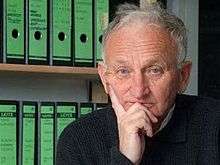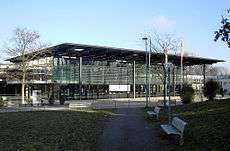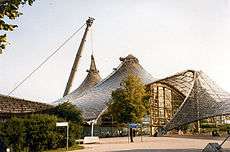Günter Behnisch
Günter Behnisch (June 12, 1922 – July 12, 2010) was a German architect, born in Lockwitz, near Dresden. During the Second World War he became one of Germany's youngest submarine commanders. Subsequently, Behnisch became one of the most prominent architects representing deconstructivism. His prominent projects included the Olympic Park in Munich and the new West German parliament in Bonn.
Günter Behnisch | |
|---|---|
 | |
| Born | June 12, 1922 Lockwitz, Germany |
| Died | July 12, 2010 (aged 88) |
| Nationality | German |
| Alma mater | Technical University in Stuttgart |
| Occupation | Architect |
| Practice | Behnisch & Partner |
Early life
Behnisch was born the second of three children, in Lockwitz near Dresden.[1] He attended a number of schools, due to the fact his Social Democrat father was arrested, sacked and redeployed to Chemnitz by the new Nazi government.[1]
In 1939, Behnisch volunteered to join the navy (Kriegsmarine), aged 17, which was a less onerous alternative to compulsory labour service, or army conscription.[1] He eventually became a U-boat officer and served aboard U-952. In October 1944, he became one of the youngest U-boat commanders,when he commissioned U-2337.[2] At the end of the Second World War he surrendered his submarine to the British and became a prisoner of war in Featherstone Castle in Northumberland.[1]
Behnisch initially trained as a bricklayer[1] then, in 1947 enrolled to study architecture at the Technical University in Stuttgart.[3] From 1967 to 1987 he was a professor for architectural/building design and industrial building technology at the Technische Hochschule Darmstadt.[4]

Architectural career
One of his most notable buildings was the new parliament in the West German capital, Bonn. Although he won the architectural design competition in 1973, the construction only began in 1987, and was completed in 1992.[3]
He established his own architecture practice in Stuttgart in 1952, which in 1966 became Behnisch & Partner.
His son Stefan Behnisch established a separate firm, Behnisch Architekten in 1989.

Completed projects
- 1972 Olympic Park in Munich, Germany[5]
- 1992 Plenary Complex of the German Parliament (Bundestag) in Bonn, Germany[6]
- 1993-2005 Academy of Arts Building in central Berlin, a six-story glass expansion of the reconstructed Hotel Adlon[7][8]
- 1997 State Clearing Bank – Landesgirokasse in Stuttgart, Germany[9]
- 1998 Control tower at Nuremberg Airport, Germany[10]
- 2002 North German State Clearing Bank in Hanover, Germany[11]
- 2003 Genzyme Center in Cambridge, Massachusetts, USA[12]
- 2005 Centre for Cellular and Biomolecular Research in Toronto, Canada[13]
References
- David Childs, Günter Behnisch: The architect behind Munich's groundbreaking Olympic Stadium, in The Independent (London), 7 August 2010, retrieved 1 March 2012
- Busch & Röll 1999, p. 29.
- Thorsten Dörting, Obituary of the Architect Günter Behnisch, in Spiegel online international, 13 July 2010, retrieved 9 August 2010
- Darmstadt, Technische Universität. "Günter Behnisch". Technische Universität Darmstadt. Retrieved 2019-09-15.
- "Sueddeutsche Article on Günther Benisch". Sueddeutsche Newspaper. Retrieved 3 June 2014.
- "Plenary Complex of the German Parliament". aedes architecture. Retrieved 3 June 2014.
- "architect Günter Behnisch dies at 88 years". die Welt (German language). Retrieved 3 November 2016.
- "Front history, rear Behnisch The Hotel Adlon in Berlin is extended". BauNetz (German language). Retrieved 3 November 2016.
- "State Clearing Bank – Landesgirokasse in Stuttgart". AW Magazine. Retrieved 3 June 2014.
- "Nürnberg International Airport (NUE/EDDN), Nuremberg, Bavaria, Germany". Airport Technology. Retrieved 3 June 2014.
- "Defining the Internal Essence of the Materiality of Institution" (PDF). Michael James Potter. Retrieved 3 June 2014.
- "German Embassy Essay on German Architects". German Embassy Kopenhagen. Archived from the original on 27 September 2016. Retrieved 3 June 2014.
- "Benisch Profile on German Architects". German Architects Website. Retrieved 3 June 2014.
Bibliography
- Busch, Rainer; Röll, Hans-Joachim (1999). German U-boat commanders of World War II : a biographical dictionary. Translated by Brooks, Geoffrey. London, Annapolis, Md: Greenhill Books, Naval Institute Press. ISBN 1-55750-186-6.CS1 maint: ref=harv (link)
External links
| Wikimedia Commons has media related to Günter Behnisch. |